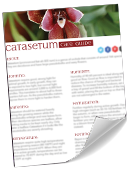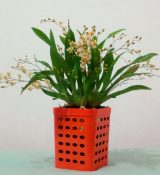Aphid Control for Orchids
Author: Melanie Dearringer7 Comments

Orchids have few problematic pests, especially when grown indoors or in greenhouses. But, there are a several insects that can devastate an orchid collection. Aphids are one. There are more varieties of aphids found in temperate climates than in the tropical regions that many orchids are native too. While there are a few problems with aphids in tropical climates, when orchids are grown in homes and greenhouses in temperate climates they are more susceptible to these tiny predators. With some prevention measures and a few control techniques, you can save your orchid collection from an aphid attack.
Aphids and Orchids

Aphids Can Harm Orchids
Aphids are small insects, ranging in size from 1-10 millimeters. They have soft bodies that can be green, black, brown, or even translucent. There are 4,400 different species of aphids. Fortunately, only 250 of those species are problematic for agriculture and gardening. Fewer than that are a problem for orchids. Aphids get their nourishment by sucking phloem sap from the plants they are inhabiting. In turn, they produce a sticky substance called honeydew. Ants often thrive on honeydew and in some situations will even farm aphids, protecting them from predators. Another aspect of aphids that makes them difficult to manage, is their ability to reproduce. Aphids can reproduce sexually or asexually and they can give birth to nymphs or lay eggs. This happens several times a year and several generations can reproduce within the same year. An aphid population can explode very quickly. When a plant becomes unfavorable to survival or overpopulated, an aphid can produce winged nymphs that will fly to colonize a new plant.
Predators
Because aphids are soft bodied, they have many predators. Their most famous predator may be the lady bug. Lacewing larvae and crab spiders are among other significant predators. Aphids are also very susceptible to various fungi and even weather such as heavy rain or too much heat. These susceptibilities give hope for management despite the prolific nature of aphids.
Signs of Infestation
You can tell your plant is infested with aphids when leaves begin to wilt and even drop. Aphids will be visible around the flower and flower spike, especially where there is new growth, and on the underside of leaves. Aphids are particularly damaging to plants in three ways. First, because they eat the sap of the plant, it puts stress on the plant and prevents important sugars and nutrients from helping the plants grow well. Second, aphids carry harmful viruses with them that can be transferred and damaging to a plant. Lastly, the honeydew that aphids leave behind is an excellent growing environment for harmful fungi.
Prevention
There are several ways you can prevent your orchid collection from being damaged by aphids. If the collection is kept in your home, it is not likely that aphids will invade, however, they may hitch a ride on an orchid purchased from a supplier and then spread to other plants. Any time you purchase a new orchid, no matter how trusted the supplier, keep it quarantined for three weeks before you place it with the rest of the collection. This will not only protect your old plants from aphids, but a host of other insect invasions as well. During this three week quarantine, check your plant daily for insects. If they are caught before there is a serious outbreak they are much easier to remove. Another simple method for prevention is to keep a catnip, garlic, or mint plant near your collection. Aphids dislike the smell of these plants and are not likely to settle near them.
Closely monitoring all of your orchid plants will help you catch an aphid infestation before it explodes. If caught early aphids can be significantly easier to control than when the population is already established and rapidly reproducing. Be sure to examine each plant closely, looking under leaves and at the connections between the stalks and leaves and around new buds.
Methods of Control
 Aphids can easily be knocked off your orchid by simply directing a stream of water at the plant where the bugs are present. If there are any heavily infested areas, you may want to consider pruning those parts of the plant. If pruning is not an option, you can use biological controls. Biological control is the introduction of beneficial insects, like the larva of lacewings, and is often used in a greenhouse setting.
Aphids can easily be knocked off your orchid by simply directing a stream of water at the plant where the bugs are present. If there are any heavily infested areas, you may want to consider pruning those parts of the plant. If pruning is not an option, you can use biological controls. Biological control is the introduction of beneficial insects, like the larva of lacewings, and is often used in a greenhouse setting.
Insecticidal soaps are another safe option. The soap removes the outer layer of the aphid causing the aphid to die from exposure. The soap must hit each individual pest in order to effectively control the outbreak. It may take several applications to make contact with all of the aphids. However, be cautious as too many applications will eventually damage the plant and any application may cause damage to the flowers. Soaps should be used no more than three times in a row. If the aphid population is still not under control, you may need to try a new method of pest management.
Horticultural oils work similarly to soaps. On contact, they suffocate the aphids. Neem oil or other oils applied every two weeks should control the population. Do not apply oils in direct sun, in environmental temperatures higher than 85 degrees, or high humidity.
Yellow card sticky traps can be used to prevent the spread of winged aphids from one plant to another. Aphids are naturally attracted to yellow and when beginning to colonize a new plant will be drawn to the yellow cards. This method cannot be expected to eradicate an aphid infestation, but it can be a good indicator of an infestation and it can help prevent the spread of aphids.
Points to Remember
To keep your orchids safe from aphids remember the following points:
- Always quarantine a new plant to prevent the introduction of aphids to your existing collection.
- Monitor vigilantly, a few aphids are easier to get rid of than a large infestation on several plants.
- Be sure to correctly identify any new pest. Different pests require different control methods.
- The safest control methods for indoor orchids are soaps or oil applications along with manual removal of adult aphids.
- It may take more than one application.
With your diligence and careful control, aphid infestations can be controlled and do not have to be the end of your beautiful orchid collection.
Sources
“Aphid,” wikipedia, <http://en.wikipedia.org/wiki/Aphid>
“Do you have bugs? Don’t Panic!” Canadian Orchid Society, Gordon Heaps, <http://www.canadianorchidcongress.ca/pests1.html>
“Orchid Pests and Diseases,” Tacoma Orchid Society, <http://tacomaorchidsociety.com/pestanddiseases.html>
“Aphids and Their Control on Orchids,” Insect Research Collection, South Dakota State University, Brookings, SD, Paul Johnson, Ph. D <http://www.staugorchidsociety.org/PDF/Johnson-Aphids.pdf>
Aphid cluster photo credit: Matt via https://www.flickr.com/photos/mattbeighton/5777574118/
7 Responses to “Aphid Control for Orchids”
Leave a Reply


Ask an Expert
Questions about orchids?
Our experts love a challenge!
Photo of the Week
Submit your photo to be featured on the blog!
More Photo of the Week Winners
Submit Photo








Nice informative article. To get rid of aphid you also consider neem and common vegetable oils, they are effective, but vegetable oils often become rancid after application. Though this may not harm the orchid, it often smells foul if the plants do not receive a regular foliar irrigation.
Good information…will these remedies work on succulents as well?
Can I use ladybugs to get rid of Aphids?
Absolutely! Here’s our post on aphid control for orchids: https://www.orchidplantcare.info/orchids-aphids-control/
Thanks.
Can rubbing alcohol be used on orchids?
Yes, you can use a cotton swab soaked in 70 percent isopropyl (rubbing) alcohol to dab off an infestation.